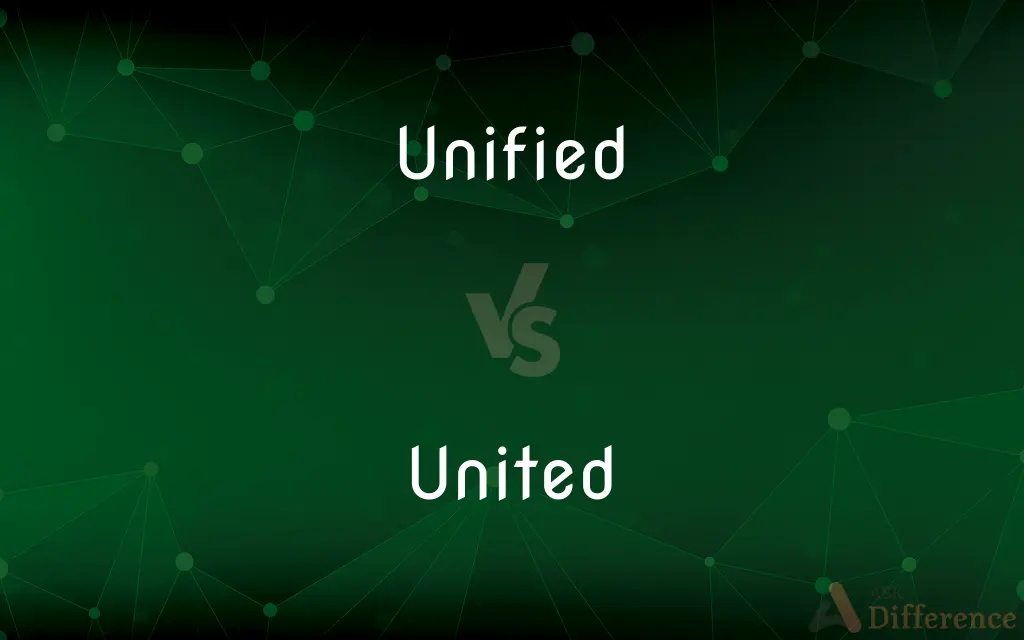Unified vs. United — What's the Difference?
By Fiza Rafique & Maham Liaqat — Updated on April 2, 2024
Unified means made into a whole or made consistent, while united refers to individuals or entities joined together for a common purpose without necessarily being integrated into a single unit.

Difference Between Unified and United
Table of Contents
ADVERTISEMENT
Key Differences
Unified is often used to describe the process or result of bringing together disparate parts to create a cohesive whole, emphasizing integration and consistency across components. This term is particularly relevant in contexts where fragmentation or division previously existed, and the goal is to achieve harmony and uniformity. United, on the other hand, suggests a condition of being allied or in agreement but does not imply the merging of identities or systems into one. It is frequently applied to groups or nations that come together to support a common cause or stance, retaining their individual identities while working towards shared objectives.
In a unified entity, the focus is on the seamless integration of elements, often aiming for a single identity or system that operates without internal contradictions. For united groups, the emphasis is on cooperation and mutual support, where the distinct characteristics of each member contribute to the collective strength without necessitating uniformity.
For instance, a unified approach to company policy means all departments adhere to the same principles and practices, presenting a consistent face internally and externally. Conversely, employees from different departments forming a united front in negotiations with management highlights solidarity and common goals without erasing departmental distinctions.
The process of becoming unified may require deeper structural or conceptual changes than simply becoming united, as it often involves reconciling differences to create a harmonious whole. In contrast, becoming united might only require agreement on objectives or opposition to a common threat, without the need for integrating systems or beliefs.
Understanding the nuances between being unified and united is essential in various fields, from politics and social movements to organizational management and international relations. While both concepts involve bringing together, the degree of integration and the preservation of individual identities distinguish one from the other.
ADVERTISEMENT
Comparison Chart
Definition
The process or result of making into a whole or homogeneous.
The act of joining together for a common purpose or cause.
Integration
High, aims for a seamless whole.
Low to moderate, retains individual identities.
Focus
Consistency and uniformity across components.
Cooperation and mutual support among distinct members.
Examples
A unified software platform.
United Nations, an organization of sovereign states.
Outcome
A single system or entity with integrated parts.
A coalition or alliance maintaining individual distinctions.
Compare with Definitions
Unified
Consistent or harmonious.
The team presented a unified strategy to tackle the problem.
United
Made up of constituents who are in agreement.
The movement is united in its demand for change.
Unified
Made or become one; integrated.
The newly unified school district consolidated resources for efficiency.
United
Allied by shared interests or objectives.
The team members are united in their goal to win the championship.
Unified
Combining elements to form a cohesive whole.
The unified software platform streamlined operations.
United
Joined together politically, for a common purpose, or by common feelings.
The allies remained united against the common enemy.
Unified
Erasing divisions or differences.
After months of discord, the community finally unified.
United
Forming a single or coherent entity from diverse parts.
The united effort led to a successful fundraiser.
Unified
Emphasizing uniformity in approach or appearance.
The company's branding is unified across all markets.
United
Agreement or harmony among individuals or groups.
Despite their differences, the family was united in times of crisis.
Unified
To make into or become a unit; consolidate.
United
Characterized by unity; being or joined into a single entity;
Presented a united front
Unified
Simple past tense and past participle of unify
United
Joined together politically, for a common purpose, or by common feelings
Women acting together in a united way
Unified
United into a whole
United
Combined into a single entity
Three united companies functioning as a single unit.
Unified
That operates as a single entity
United
Concerned with, produced by, or resulting from mutual action
A united effort to combat neighborhood crime.
Unified
That serves all grade levels between kindergarten and twelfth grade.
United
Being in harmony; agreed
Supported the policy as a united student body.
Unified
Formed or united into a whole
United
Simple past tense and past participle of unite
Unified
Operating as a unit;
A unified utility system
A coordinated program
United
Joined into a single entity.
United
Involving the joint activity of multiple agents.
United
Combined; joined; made one.
United
Involving the joint activity of two or more;
The attack was met by the combined strength of two divisions
Concerted action
The conjunct influence of fire and strong dring
The conjunctive focus of political opposition
A cooperative effort
A united effort
Joint military activities
United
Of or relating to two people who are married to each other
Common Curiosities
What distinguishes a unified government system?
A unified government system operates under a single set of laws and administrative structures, aiming for consistent governance across all regions.
What does it mean when a country is described as unified?
It means the country has achieved a state of being one entity, often after merging different regions, groups, or ideologies into a cohesive whole.
How do united efforts contribute to social movements?
United efforts in social movements bring together diverse groups and individuals who share common goals, enhancing their collective strength and impact without necessitating uniformity in all aspects.
Can an organization be both unified and united?
Yes, an organization can be both unified in its policies and practices (integration) and united in its goals or against external challenges (cooperation).
How does a unified approach impact organizational culture?
A unified approach fosters a cohesive organizational culture by ensuring that all members share and operate under the same values, goals, and practices, leading to a strong, harmonious work environment.
What is a unified theory?
A unified theory is a single framework that explains multiple aspects of a field or phenomenon, integrating various concepts into a cohesive whole.
Can a nation be united without being unified?
Yes, a nation can be united in purpose or cause, such as during a crisis, while still maintaining diverse cultures, ideologies, or political systems.
What leads to the formation of a united front?
A united front is formed when different groups or individuals come together to face a common challenge or pursue a shared objective, emphasizing solidarity over integration.
What challenges can arise when trying to unify a diverse group?
Challenges in unifying a diverse group include overcoming inherent differences in opinions, beliefs, and practices; addressing potential resistance to change; and finding common ground that respects and integrates the variety of perspectives present.
What are the benefits of a united stance in international relations?
A united stance in international relations can enhance diplomatic leverage, present a stronger negotiation position, and provide mutual support among countries facing common external pressures or threats, without compromising their sovereignty.
Is a unified approach always better than a united approach?
Not necessarily; the choice between a unified or united approach depends on the context and goals. Unified approaches are effective for consistency, while united approaches allow for diversity within cooperation.
How do united movements influence policy changes?
United movements, by bringing together diverse groups under common causes, can exert significant social and political pressure, compelling policymakers to consider and often enact changes in response to the collective demand.
Can a sports team be considered unified?
A sports team can be considered unified if all members and staff work seamlessly towards common goals, share the same strategies, and exhibit a single team identity both on and off the field.
Share Your Discovery

Previous Comparison
Irrational vs. Rational
Next Comparison
Dimer vs. MonomerAuthor Spotlight
Written by
Fiza RafiqueFiza Rafique is a skilled content writer at AskDifference.com, where she meticulously refines and enhances written pieces. Drawing from her vast editorial expertise, Fiza ensures clarity, accuracy, and precision in every article. Passionate about language, she continually seeks to elevate the quality of content for readers worldwide.
Co-written by
Maham Liaqat













































